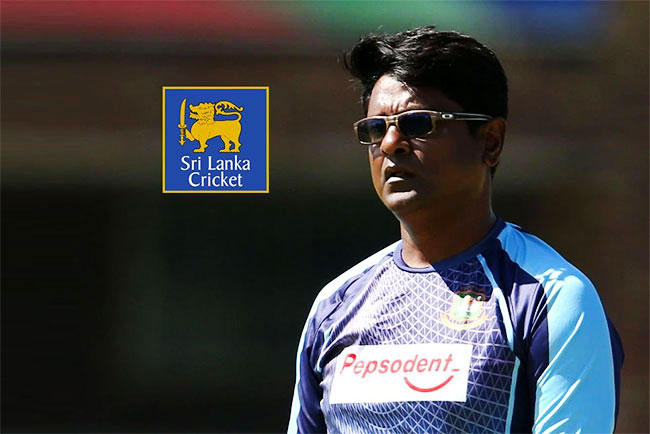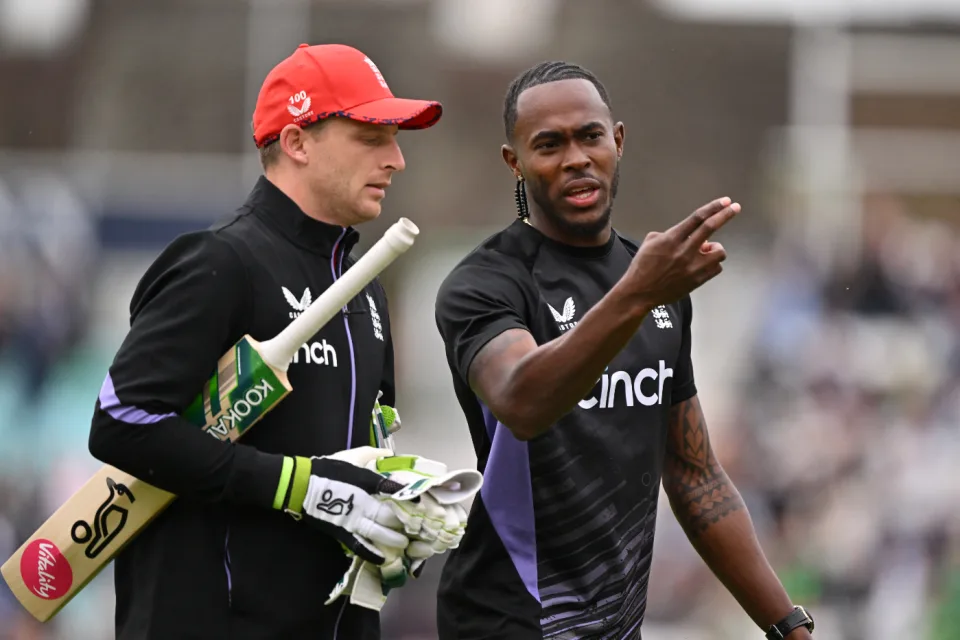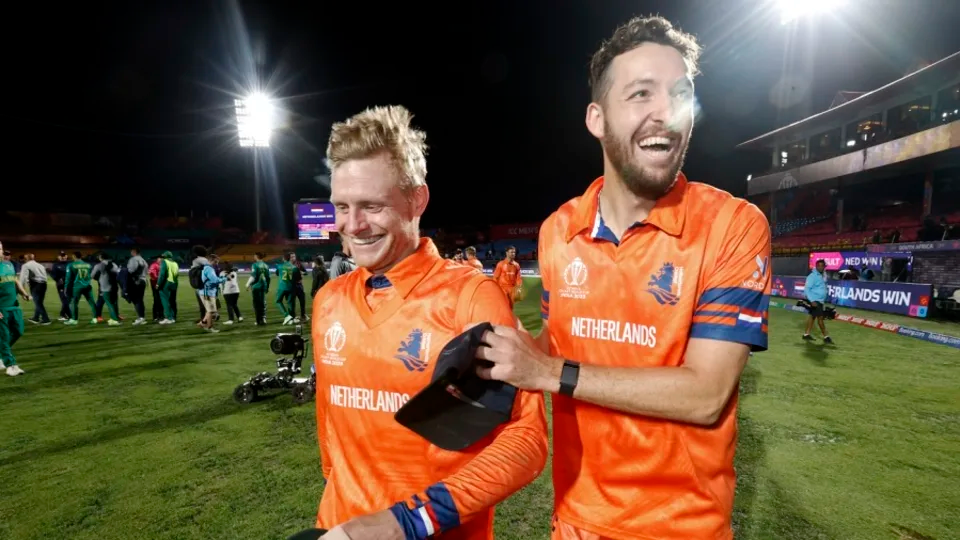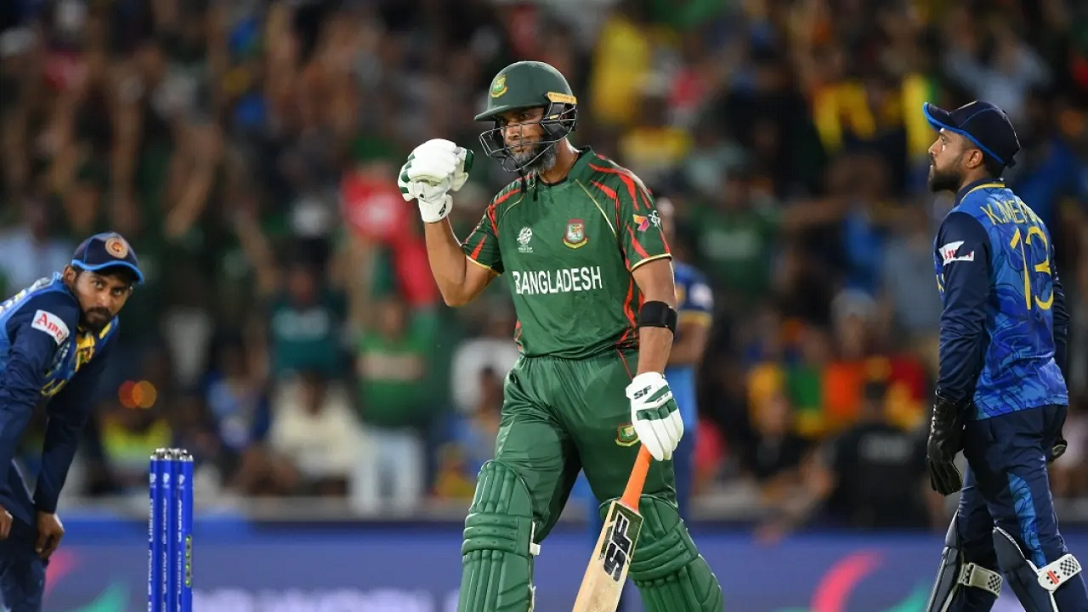Sports
Relief to see Dhananjaya among the runs: Naveed Nawaz

Sri Lanka secured a much-needed victory against Afghanistan to keep their slender hopes of qualification for the semifinals alive. Naveed Nawaz, Sri Lanka’s assistant coach, said it was an important victory for the team who also tried to reach the target of 145 as soon as possible for a lift in their net run rate but were able to finish it only in the penultimate over.
“Yeah, the net run rate was important. On the other hand, the win was important as well,” said Nawaz when asked if Sri Lanka could have got to the target sooner. “So we were keeping an eye on the net run rate as well while trying to secure a win. That was the most important thing for us. At the rate things were going, we were chasing 144, which we needed to get in at least 18-plus overs, which would jack up our net run rate into a decent position.”
Sri Lanka, with two wins from four games, will play against England in their final group encounter. Nawaz said they will go out with a positive mindset, attempting to win the game and boost their net run rate while hoping for other results to go their way.
“There’s one more game to go, and I think in our minds we’ve got to go hard and we’ve got to win that game and see where the tournament ends up. I think we’ll have to depend on how Australia goes in their next game to see if we have got any outside chance of making it to the semis,” he said.
Dhananjaya de Silva was the star batter for Sri Lanka in this game, with his unbeaten 66 off 42 helping the team over the line with six wickets in hand. He was involved in useful partnerships with Kusal Mendis, Charith Asalanka and Bhanuka Rajapaksa as Sri Lanka came up with a much-improved effort with the bat compared to their previous game where they had slipped to 24 for 5 against New Zealand.
“It’s always the case that we’ve been talking to lose less wickets during the powerplay as well as the first ten overs, where if you look at the pattern that’s building in most teams, the number of runs that you get in the first ten overs has been far less than the subcontinent. And the number of runs you get at the bottom end has been quite a bit. So that’s always been our plan during this World Cup, and whenever we had a good opening stand or someone taking responsibility from the top to move on, we’ve done well,” said Nawaz.
“I think it’s a relief that Dhananjaya is coming into runs. He’s always shown potential — 30s, 40s, 20s all the time. But I think it’s good to see him finishing a game and coming through that game over 60 not out, which is a good sign for us,” he added.
Nawaz also heaped praise on Wanindu Hasaranga, who finished with 3 for 13, which included two wickets and only three runs in the 20th over. “He’s always been one of our main bowlers and one of the top bowlers in the world. So that’s why we back him to bowl in the last over of the game as well, and he handled it brilliantly, bowled really well. I think that was one of the reasons that we could keep the Afghans below 150.”
Meanwhile, Afghanistan’s hopes of progressing further came to an end with this loss. Head coach Jonathan Trott said it was a mixed-bag campaign for the team where there didn’t capitalise on chances. He provided examples of the matches against England and also this game, where Afghanistan weren’t able to finish well with the bat.
“I’d say there’s been some good parts and there’s been some really average parts. We haven’t got things right. We seem to be able to get ourselves into positions but then not utilise them and actually then kick on with the batting,” Trott said. “So twice now, against England and this game. I’m not saying against England we would have had a massive score, but we would have certainly been able to put a lot more pressure on England if we’d been a little bit smarter in the last couple overs, and the same here.
“I think we lost four overs and we only got 31 runs, so 24 balls. Only being four wickets down, that’s not good enough. Those sort of areas are what can sort of take the game away from the opposition, or if you don’t get it right, bring them back into it,” he said. “We were definitely a few runs short. When your last over goes to three runs, you certainly left a few out there. We could have done a lot better with the bat. We got into position to kick on and didn’t utilise the short boundary anywhere near enough.”
Sports
England face Australia in the battle of champions

The first truly heavyweight clash of this expanded T20 World Cup format comes freighted with both history and subplots. A rematch of the 2010 World T20 final at Kensington Oval, the match pits Jos Buttler’s defending champions – who are aiming to become the first team to retain the trophy – against the Australian winning machine, victors at the 2021 edition and current world title-holders in Test and ODI cricket. And that’s before you throw in the Ashes for afters.
Already there is added pressure on England, after the rain in Bridgetown led to a share of the points in their opener against Scotland (and that having conceded 90 runs from 10 overs without taking a wicket in a tepid bowling display). Lose to their oldest rivals and it will leave their Super 8 prospects open to being waylaid by the perils of net run-rate calculations, or worse.
The Scotland match was the third abandonment in five suffered by England, after a rain-affected home series against Pakistan, which has clearly hampered their readiness for this campaign after almost six months without playing T20 together. It does not take much for a side to click in this format – and England looked in decent shape when they did get on the field against Pakistan – but Buttler will be anxious for things to go their way on Saturday, if only to avoid further questions referencing the team’s disastrous ODI World Cup defence last year.
Australia, under the laidback leadership of Mitchell Marsh would love nothing more than to add to the English sense of jeopardy – having helped bundle them out of the tournament in India on the way to taking the crown. Their head to head record is less impressive in T20 however, with England having won six of the last seven completed encounters, as well as that 2010 final.
Despite a wobble with the bat, Australia avoided mishap against Oman earlier in the week, the experience of David Warner and Marcus Stoinis shining through in difficult batting conditions. Surfaces in the Caribbean – not to mention those games staged in the USA – have already had teams scratching their heads; rather than the “slug-fest” England had prepared for, following a high-scoring tour of the Caribbean in December, it looks as if boxing smart may be the way to go.
Speaking of Warner, this could be the last time he faces up against England in national colours – and another match-winning contribution would likely reduce the chances of them meeting again in the knockouts. On the other side of the card is Jofra Archer, fresh from an emotional maiden outing at Kensington Oval and ready to take on Australia for the first time in any format since 2020. Can Mark Wood fire up England’s campaign, as he did during last summer’s Ashes? Will Pat Cummins be back to harass the old enemy once again? Seconds out, it’s almost time to rumble.
Cummins is set to return after being rested for the Oman game, which saw Mitchell Starc leave the field with cramp. Starc is understood to be fine and could keep his place – which would likely see Nathan Ellis miss out. Marsh is still not fit to bowl, with Australia likely to continue with the allrounder combination of Stoinis and Maxwell to give them cover.
Australia (probable XI): David Warner, Travis Head, Mitchell Marsh (capt), Glenn Maxwell, Marcus Stoinis, Josh Inglis (wk), Tim David, Pat Cummins, Nathan Ellis/Mitchell Starc, Adam Zampa, Josh Hazlewood
The one change England may consider is Reece Topley coming in for Wood, with the expectation that there will be some rotation among the seamers through the course of the tournament.
England (probable XI): Phil Salt, Jos Buttler (capt & wk), Will Jacks, Jonny Bairstow, Harry Brook, Liam Livingstone, Moeen Ali, Chris Jordan, Jofra Archer, Adil Rashid, Reece Topley/Mark Wood
[Cricinfo]
Sports
South Africa up against their bogey team in batter-unfriendly New York

Once is coincidence, twice is a clue, and three times is proof.
To paraphrase Agatha Christie, that is the narrative around South Africa’s meeting with Netherlands at this T20 World Cup.
The Dutch beat South Africa at the 2022 tournament and ended their semi-final hopes in a match where South Africa appeared to be sleep walking, and then beat them again at the 2023 ODI World Cup, where they exposed South Africa’s vulnerability in the chase. If they to do the treble, not only will Netherlands take the lead in Group D, but they will offer conclusive evidence of the threat they pose to Full Members, especially South Africa.
Of course, it will take some doing after South Africa’s opening performance against Sri Lanka, where they reduced their opposition to their lowest T20I total and chased it down in fairly straightforward fashion thanks to the most stable middle-order of their white-ball era. In Aiden Markram, Tristan Stubbs, Heinrich Klaasen and David Miller, South Africa have bankers and big-hitters and, for this match, they also have the advantage of experience. They’ve already played at Eisenhower Park, and have first-hand knowledge that run-scoring doesn’t come easily;Klassen said they are prepared to use their “cricket brains” and play “smarter cricket”.
But the conditions could be good news for Netherlands, who are not naturally a line-up of big hitters and build their innings on a foundation of turning ones into twos. In other words, they tend to take a slightly more conservative approach to batting, which may work well here, but they’ll be wary of the uneven bounce of the surface and will have to come up with plans to counterattack especially against South Africa’s seamers. Their own bowlers were exemplary in Dallas and will look to build on that performance against a line-up that will likely be more proactive than Nepal’s, but who they have managed to keep quiet not once, but twice in the past. Third time’s the charm, they say.
Anrich Nortje’s stunning return to form against Sri Lanka means South Africa may not have to tinker with the bowling combination, and Gerald Coetzee and Tabraiz Shamsi may have to wait their turns to get a game. The batting line-up should be unchanged, with no space for Ryan Rickelton yet.
South Africa: Quinton de Kock (wk), Reeza Hendricks, Aiden Markam, Tristan Stubbs, Heinrich Klaasen (wk), David Miller, Marco Jansen, Keshav Maharaj, Kagiso Rabada, Ottneil Baartman, Anrich Nortje
Conditions in New York may tempt Netherlands to include an extra seamer and they have Kyle Klein in their squad. But it could come at the expense of a shortened batting line-up and they may not want to risk that.
Netherlands: Michael Levitt, Max O’Dowd, Vikramjit Singh, Sybrand Engelbrecht, Scott Edwards (capt, wk), Bas de Leede, Teja Nidamanuru, Logan van Beek, Tim Pringle, Paul van Meekeren, Vivian Kingma
[Cricinfo]
Latest News
Mustafizur, Rishad, Hridoy dazzle in Bangladesh’s tight two-wicket win over Sri Lanka

Nuwan Thushara’s last over brought Sri Lanka screaming back into the match,as he first bowled Rishad Hossain, and then nailed Taskin Ahmed in front of the stumps with a pinpoint swinging yorker. This left Bangladesh eight wickets down, with 12 runs still to get.
However, the experienced Mahmudullah was at the crease for Bangladesh, and despite some further nervy moments, pushed Bangladesh across the line off the last ball of the 19th over.
But this was a match chiefly decided by Bangladesh’s own outstanding bowling. Mustafizur Rahman was the best among them, using shorter lengths and his cutters efficiently, to claim figures of 3 for 17. Rishad Hossain’s three-for through the middle overs also kept Sri Lanka quiet.
Mustafizur was instrumental in Sri Lanka’s downward spiral through the middle overs, which culminated in a crash-and-burn end. Ultimately, their inability to find boundaries, or even rotate strike against good Bangladesh bowling resulted in their downfall. A score of 125 for 9 always seemed poor on a decent pitch, even if their bowlers made a match of it in the end.
Brief scores:
Bangladesh 125 for 8 in 19 overs (Towhid Hridoy 40, Litton Das 36; Dhanajaya de Silva 1-11, Nuwan Thushara 4-18, Wanidu Hasaranga 2-32, Matheesha Pathirana 1-27) beat Sri Lanka124 for 9 in 20 overs (Pathum Nissanka 47, Dhananjaya de Silva 21; Tanzim Hasan Sakib 1-24, Taskin Ahmed 2-25, Mustafizur Rahman 3-17, Rishad Hossain 3-22) by two wickets
[Cricinfo]












